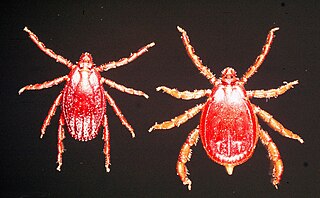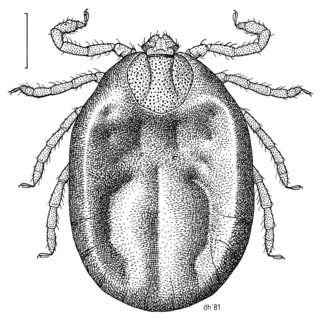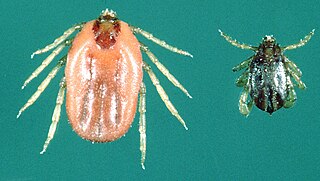
Babesiosis is a malaria-like parasitic disease caused by infection with Babesia, a type of Apicomplexa. Human babesiosis transmission via tick bite is most common in the Northeastern and Midwestern United States and parts of Europe, and sporadic throughout the rest of the world. It occurs in warm weather. People can get infected with Babesia parasites by the bite of an infected tick, by getting a blood transfusion from an infected donor of blood products, or by congenital transmission . Ticks transmit the human strain of babesiosis, so it often presents with other tick-borne illnesses such as Lyme disease. After trypanosomes, Babesia is thought to be the second-most common blood parasite of mammals, and they can have a major impact on health of domestic animals in areas without severe winters. In cattle the disease is known as Texas cattle fever, redwater, or piroplasmosis.
The Kadam virus is a tick-borne Flavivirus.

Theileria is a genus of parasites that belongs to the phylum Apicomplexa, and is closely related to Plasmodium. Two Theileria species, T. annulata and T. parva, are important cattle parasites. T. annulata causes tropical theileriosis and T. parva causes East Coast fever. Theileria species are transmitted by ticks. The genomes of T. orientalis Shintoku, Theileria equi WA, Theileria annulata Ankara and Theileria parva Muguga have been sequenced and published.
Heartwater is a tick-borne rickettsial disease of domestic and wild ruminants. It is caused by Ehrlichia ruminantium - an intracellular Gram-negative coccal bacterium. The disease is spread by bont ticks, which are members of the genus Amblyomma. Affected mammals include cattle, sheep, goats, antelope, and buffalo, but the disease has the biggest economic impact on cattle production in affected areas. The disease's name is derived from the fact that fluid can collect around the heart or in the lungs of infected animals.

Rhipicephalus sanguineus, commonly called the brown dog tick, kennel tick, or pantropical dog tick, is a species of tick found worldwide, but more commonly in warmer climates. This species is unusual among ticks in that its entire lifecycle can be completed indoors. The brown dog tick is easily recognized by its reddish-brown color, elongated body shape, and hexagonal basis capituli. Adults are 2.28 to 3.18 mm in length and 1.11 to 1.68 mm in width. They do not have ornamentation on their backs.

Rickettsia conorii is a Gram-negative, obligate intracellular bacterium of the genus Rickettsia that causes human disease called boutonneuse fever, Mediterranean spotted fever, Israeli tick typhus, Astrakhan spotted fever, Kenya tick typhus, Indian tick typhus, or other names that designate the locality of occurrence while having distinct clinical features. It is a member of the spotted fever group and the most geographically dispersed species in the group, recognized in most of the regions bordering on the Mediterranean Sea and Black Sea, Israel, Kenya, and other parts of North, Central, and South Africa, and India. The prevailing vector is the brown dog tick, Rhipicephalus sanguineus. The bacterium was isolated by Emile Brumpt in 1932 and named after A. Conor, who in collaboration with A. Bruch, provided the first description of boutonneuse fever in Tunisia in 1910.
Babesia bovis is a single-celled parasite of cattle which occasionally infects humans. It is a member of the phylum Apicomplexa, which also includes the malaria parasite. The disease it and other members of the genus Babesia cause is a hemolytic anemia known as babesiosis and colloquially called Texas cattle fever, redwater or piroplasmosis. It is transmitted by bites from infected larval ticks of the order Ixodida. It was eradicated from the United States by 1943, but is still present in Mexico and much of the world's tropics. The chief vector of Babesia species is the southern cattle fever tick Rhipicephalus microplus.
Haematoxenus is a genus of parasitic alveolates of the phylum Apicomplexa.

Ticks of domestic animals directly cause poor health and loss of production to their hosts by many parasitic mechanisms. Ticks also transmit numerous kinds of viruses, bacteria, and protozoa between domestic animals. These microbes cause diseases which can be severely debilitating or fatal to domestic animals, and may also affect humans. Ticks are especially important to domestic animals in tropical and subtropical countries, where the warm climate enables many species to flourish. Also, the large populations of wild animals in warm countries provide a reservoir of ticks and infective microbes that spread to domestic animals. Farmers of livestock animals use many methods to control ticks, and related treatments are used to reduce infestation of companion animals.
Rhipicephalus hoogstraali is a tick found in Djibouti and Somalia. First recognized by Harry Hoogstraal as Rhipicephalus longicoxatus based on an incomplete published description, after discovery of the holotype of R. longicoxatus, it was described and named to honor Hoogstraal in 2009.
Haemaphysalis bispinosa is a hard-bodied tick of the genus Haemaphysalis. It is found in India, Sri Lanka, Myanmar, Pakistan, Nepal, Australia, and Indonesia. It is an obligate ectoparasite of mammals. It is a potential vector of Kyasanur Forest disease virus. These ticks was found parasitized by a chalcid Hunterellus sagarensis in these diseased areas.

The Yellow Dog Tick,, is a hard-bodied tick of the genus Haemaphysalis. It is also known as African dog tick, or simply as dog tick in many parts of the world.
Rhipicephalus haemaphysaloides is a hard-bodied tick of the genus Rhipicephalus. It is one of the major medically important ticks in the world.

Rhipicephalus pulchellus is a species of hard tick. It is a very common tick in the Horn of Africa, with a habitat of the Rift Valley and eastward. It hosts upon a wide variety of species, including livestock, wild mammals, and humans, and can be a vector for various pathogens. The adult male has a distinctive black and ivory ornamentation on its scutum.

Rhipicephalus appendiculatus, the brown ear tick, is a hard tick found in Africa where it spreads the parasite Theileria parva, the cause of East Coast fever in cattle. The tick has a three-host life-cycle, spending around 10% of its life feeding on animals. The most common host species include buffalo, cattle, and large antelope, but R. appendiculatus is also found on other animals, such as hares, dogs, and warthogs.
Rhipicephalus gertrudae is a species of tick in the family Ixodidae. The specific epithet honors South African parasitologist Dr. Gertrud Theiler. The species was first circumscribed by Dr. Brouria Feldman-Muhsam.












